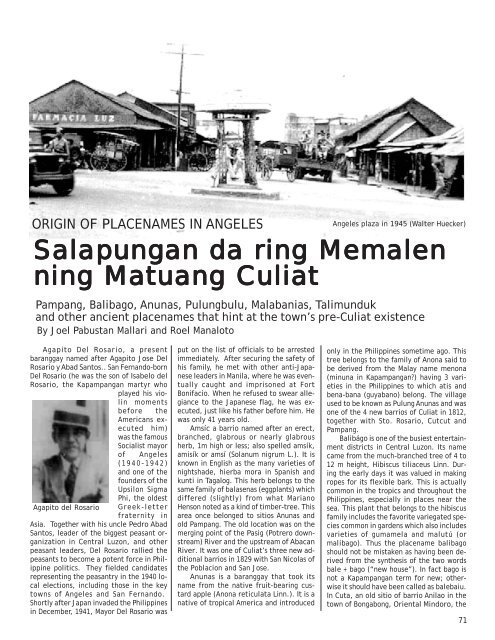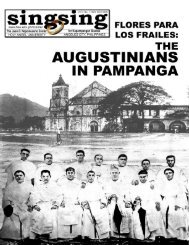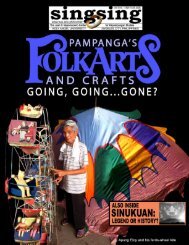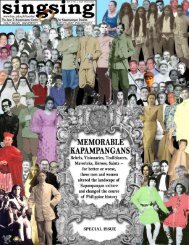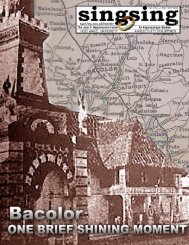Download PDF - Holy Angel University
Download PDF - Holy Angel University
Download PDF - Holy Angel University
Create successful ePaper yourself
Turn your PDF publications into a flip-book with our unique Google optimized e-Paper software.
ORIGIN OF PLACENAMES IN ANGELES<br />
Sala Salapung<br />
Sala pung pungan pung an da da ring ring Memalen<br />
Memalen<br />
ning ning Ma Matuang Ma tuang Culia Culiat Culia<br />
Pampang, Balibago, Anunas, Pulungbulu, Malabanias, Talimunduk<br />
and other ancient placenames that hint at the town’s pre-Culiat existence<br />
By Joel Pabustan Mallari and Roel Manaloto<br />
Agapito Del Rosario, a present<br />
baranggay named after Agapito Jose Del<br />
Rosario y Abad Santos.. San Fernando-born<br />
Del Rosario (he was the son of Isabelo del<br />
Rosario, the Kapampangan martyr who<br />
played his violin<br />
moments<br />
before the<br />
Americans executed<br />
him)<br />
was the famous<br />
Socialist mayor<br />
of <strong>Angel</strong>es<br />
(1940-1942)<br />
and one of the<br />
founders of the<br />
Upsilon Sigma<br />
Agapito del Rosario<br />
Phi, the oldest<br />
Greek-letter<br />
fraternity in<br />
Asia. Together with his uncle Pedro Abad<br />
Santos, leader of the biggest peasant organization<br />
in Central Luzon, and other<br />
peasant leaders, Del Rosario rallied the<br />
peasants to become a potent force in Philippine<br />
politics. They fielded candidates<br />
representing the peasantry in the 1940 local<br />
elections, including those in the key<br />
towns of <strong>Angel</strong>es and San Fernando.<br />
Shortly after Japan invaded the Philippines<br />
in December, 1941, Mayor Del Rosario was<br />
put on the list of officials to be arrested<br />
immediately. After securing the safety of<br />
his family, he met with other anti-Japanese<br />
leaders in Manila, where he was eventually<br />
caught and imprisoned at Fort<br />
Bonifacio. When he refused to swear allegiance<br />
to the Japanese flag, he was executed,<br />
just like his father before him. He<br />
was only 41 years old.<br />
Amsíc a barrio named after an erect,<br />
branched, glabrous or nearly glabrous<br />
herb, 1m high or less; also spelled amsík,<br />
amisík or amsí (Solanum nigrum L.). It is<br />
known in English as the many varieties of<br />
nightshade, hierba mora in Spanish and<br />
kunti in Tagalog. This herb belongs to the<br />
same family of balasenas (eggplants) which<br />
differed (slightly) from what Mariano<br />
Henson noted as a kind of timber-tree. This<br />
area once belonged to sitios Anunas and<br />
old Pampang. The old location was on the<br />
merging point of the Pasig (Potrero downstream)<br />
River and the upstream of Abacan<br />
River. It was one of Culiat’s three new additional<br />
barrios in 1829 with San Nicolas of<br />
the Poblacion and San Jose.<br />
Anunas is a baranggay that took its<br />
name from the native fruit-bearing custard<br />
apple (Anona reticulata Linn.). It is a<br />
native of tropical America and introduced<br />
<strong>Angel</strong>es plaza in 1945 (Walter Huecker)<br />
only in the Philippines sometime ago. This<br />
tree belongs to the family of Anona said to<br />
be derived from the Malay name menona<br />
(minuna in Kapampangan?) having 3 varieties<br />
in the Philippines to which atis and<br />
bena-bana (guyabano) belong. The village<br />
used to be known as Pulung Anunas and was<br />
one of the 4 new barrios of Culiat in 1812,<br />
together with Sto. Rosario, Cutcut and<br />
Pampang.<br />
Balibágo is one of the busiest entertainment<br />
districts in Central Luzon. Its name<br />
came from the much-branched tree of 4 to<br />
12 m height, Hibiscus tiliaceus Linn. During<br />
the early days it was valued in making<br />
ropes for its flexible bark. This is actually<br />
common in the tropics and throughout the<br />
Philippines, especially in places near the<br />
sea. This plant that belongs to the hibiscus<br />
family includes the favorite variegated species<br />
common in gardens which also includes<br />
varieties of gumamela and malutú (or<br />
malibago). Thus the placename balibago<br />
should not be mistaken as having been derived<br />
from the synthesis of the two words<br />
bale + bago (“new house”). In fact bago is<br />
not a Kapampangan term for new; otherwise<br />
it should have been called as balebaiu.<br />
In Cuta, an old sitio of barrio Anilao in the<br />
town of Bongabong, Oriental Mindoro, the<br />
71


